In-Depth Report: Breast Cancer Prevalence, Risk Factors, and Services
VerifiedAdded on 2023/06/05
|9
|1917
|122
Report
AI Summary
This report provides an analysis of breast cancer, focusing on its prevalence, social and environmental determinants, and available services for patients. It highlights the increasing prevalence of breast cancer, particularly in developed countries, and discusses the impact on the quality of life. The report identifies key environmental factors such as tobacco smoke and chest X-rays, and social factors like gender and age, as significant determinants shaping breast cancer risk. It also evaluates the services available to breast cancer patients, including breast care nurses, screening programs, and counseling services, while critiquing the effectiveness and drawbacks of screening methods like mammograms and MRIs. The report concludes with recommendations for lifestyle changes and increased awareness, emphasizing the importance of early detection and healthy living to mitigate the risks associated with breast cancer. Desklib offers a platform for students to access similar solved assignments and past papers for academic assistance.
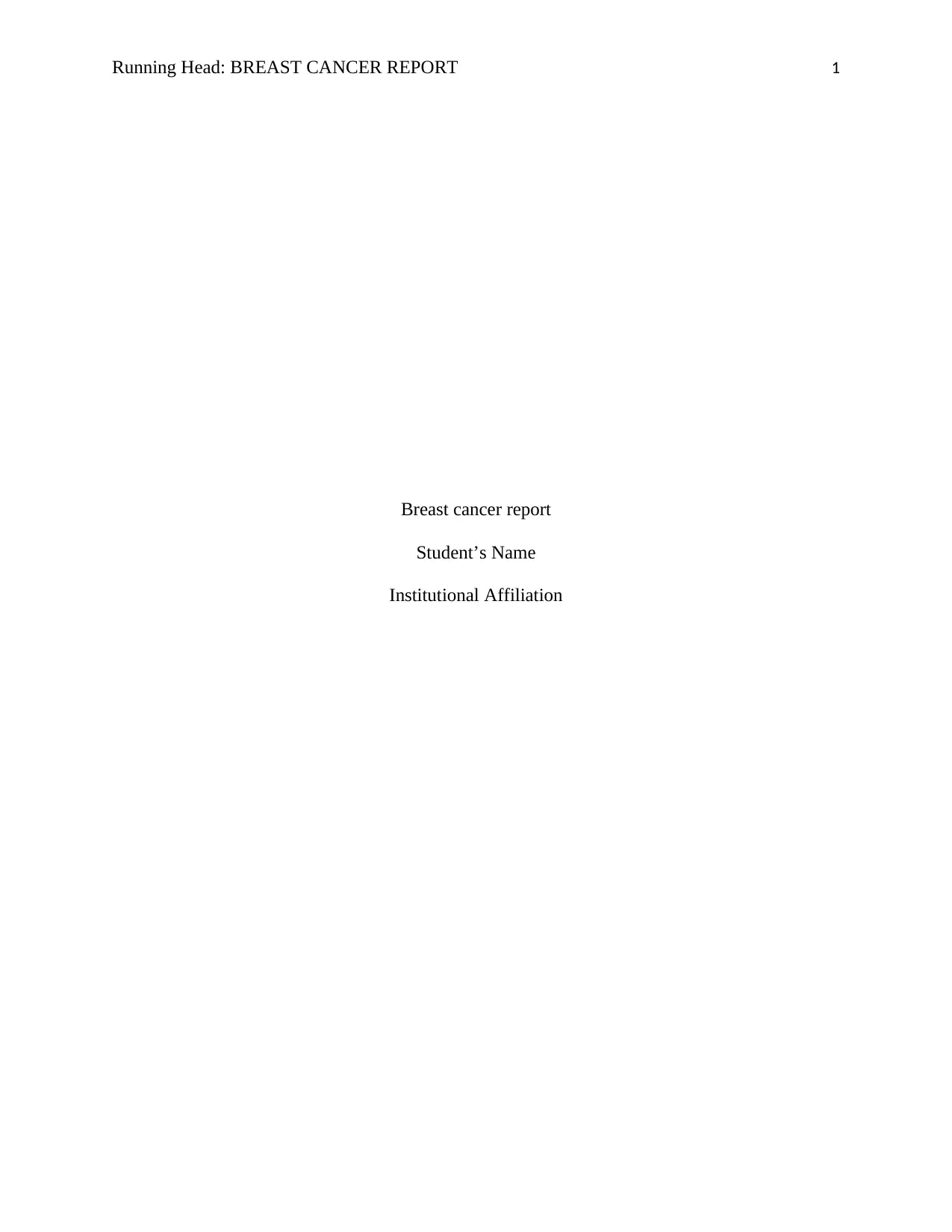
Running Head: BREAST CANCER REPORT 1
Breast cancer report
Student’s Name
Institutional Affiliation
Breast cancer report
Student’s Name
Institutional Affiliation
Paraphrase This Document
Need a fresh take? Get an instant paraphrase of this document with our AI Paraphraser
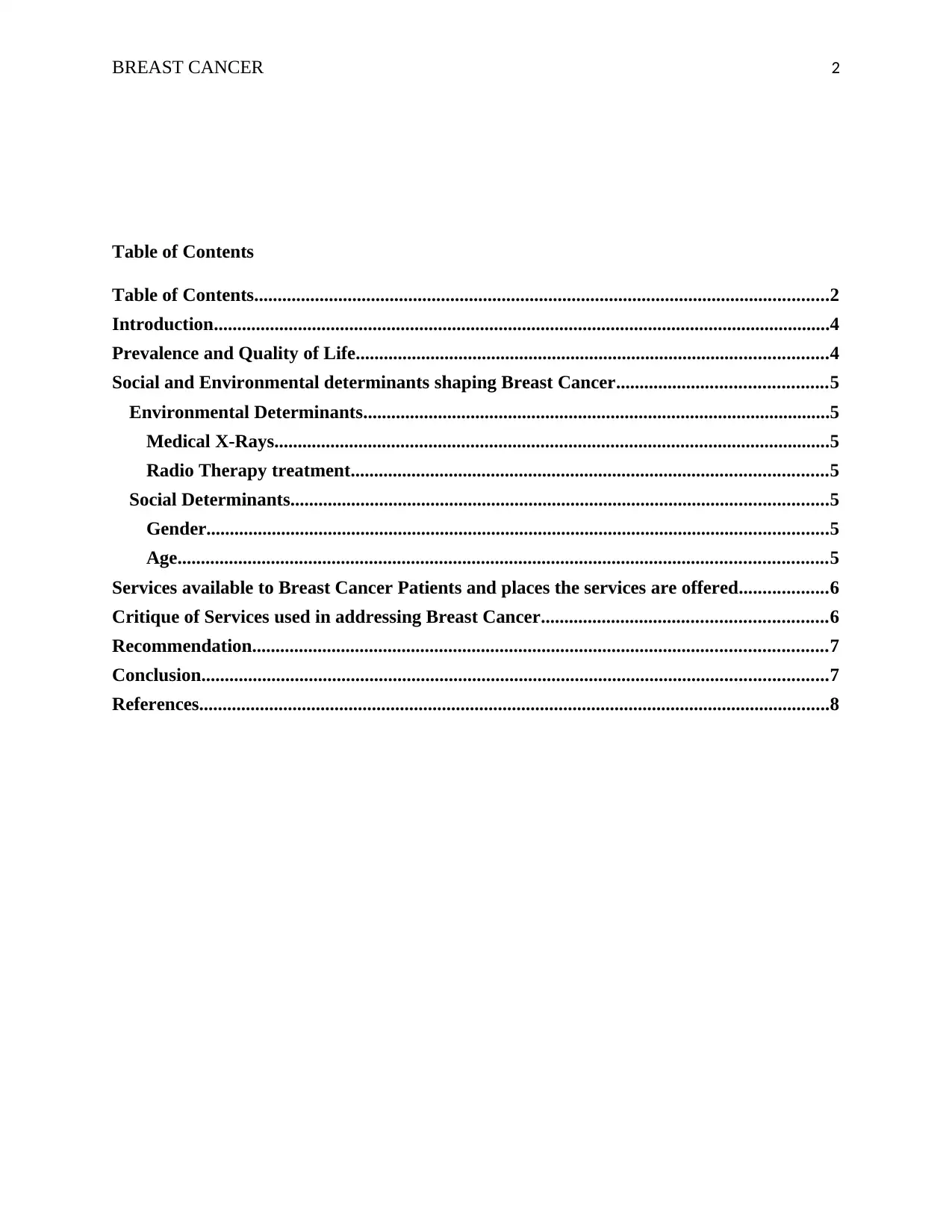
BREAST CANCER 2
Table of Contents
Table of Contents...........................................................................................................................2
Introduction....................................................................................................................................4
Prevalence and Quality of Life.....................................................................................................4
Social and Environmental determinants shaping Breast Cancer.............................................5
Environmental Determinants....................................................................................................5
Medical X-Rays.......................................................................................................................5
Radio Therapy treatment......................................................................................................5
Social Determinants...................................................................................................................5
Gender.....................................................................................................................................5
Age...........................................................................................................................................5
Services available to Breast Cancer Patients and places the services are offered...................6
Critique of Services used in addressing Breast Cancer.............................................................6
Recommendation...........................................................................................................................7
Conclusion......................................................................................................................................7
References.......................................................................................................................................8
Table of Contents
Table of Contents...........................................................................................................................2
Introduction....................................................................................................................................4
Prevalence and Quality of Life.....................................................................................................4
Social and Environmental determinants shaping Breast Cancer.............................................5
Environmental Determinants....................................................................................................5
Medical X-Rays.......................................................................................................................5
Radio Therapy treatment......................................................................................................5
Social Determinants...................................................................................................................5
Gender.....................................................................................................................................5
Age...........................................................................................................................................5
Services available to Breast Cancer Patients and places the services are offered...................6
Critique of Services used in addressing Breast Cancer.............................................................6
Recommendation...........................................................................................................................7
Conclusion......................................................................................................................................7
References.......................................................................................................................................8
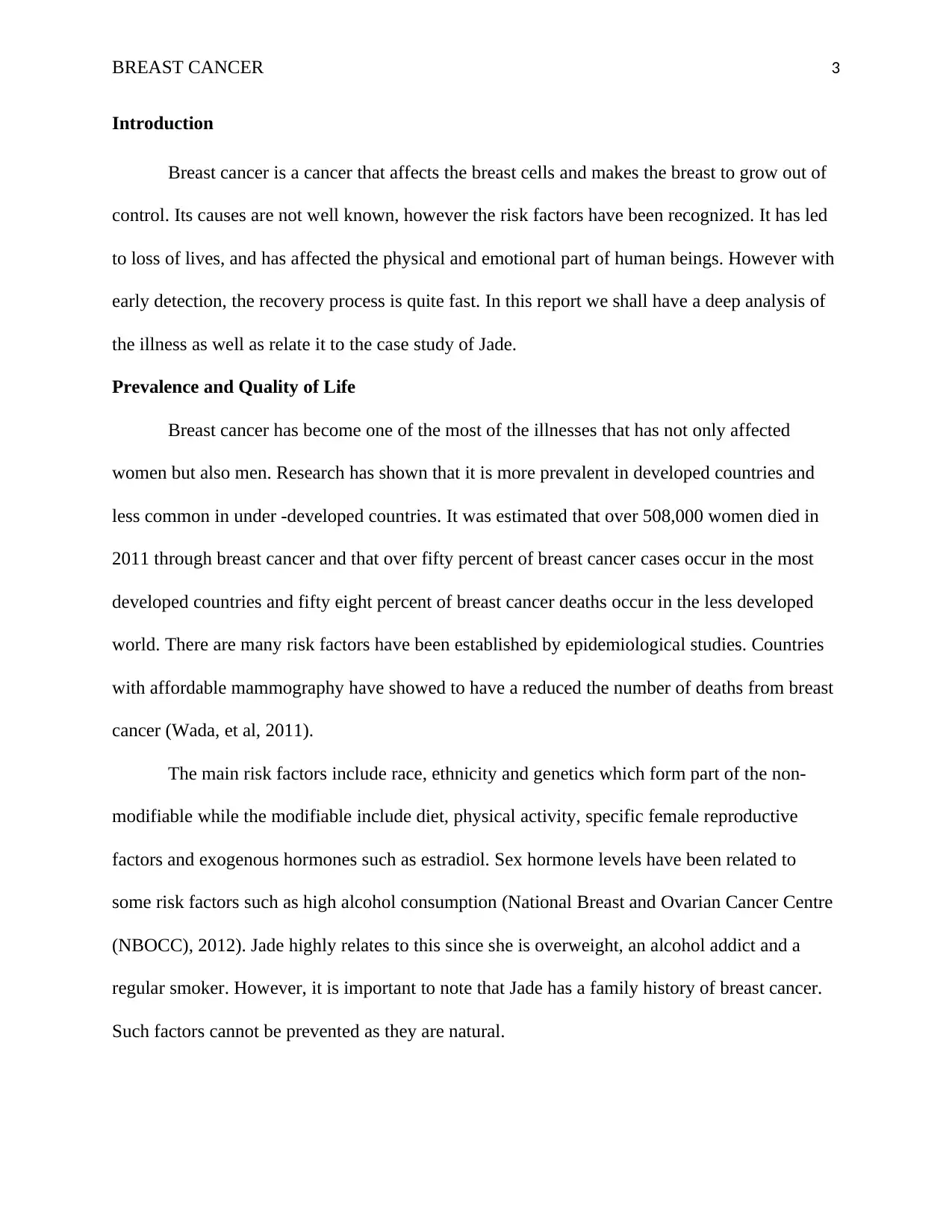
BREAST CANCER 3
Introduction
Breast cancer is a cancer that affects the breast cells and makes the breast to grow out of
control. Its causes are not well known, however the risk factors have been recognized. It has led
to loss of lives, and has affected the physical and emotional part of human beings. However with
early detection, the recovery process is quite fast. In this report we shall have a deep analysis of
the illness as well as relate it to the case study of Jade.
Prevalence and Quality of Life
Breast cancer has become one of the most of the illnesses that has not only affected
women but also men. Research has shown that it is more prevalent in developed countries and
less common in under -developed countries. It was estimated that over 508,000 women died in
2011 through breast cancer and that over fifty percent of breast cancer cases occur in the most
developed countries and fifty eight percent of breast cancer deaths occur in the less developed
world. There are many risk factors have been established by epidemiological studies. Countries
with affordable mammography have showed to have a reduced the number of deaths from breast
cancer (Wada, et al, 2011).
The main risk factors include race, ethnicity and genetics which form part of the non-
modifiable while the modifiable include diet, physical activity, specific female reproductive
factors and exogenous hormones such as estradiol. Sex hormone levels have been related to
some risk factors such as high alcohol consumption (National Breast and Ovarian Cancer Centre
(NBOCC), 2012). Jade highly relates to this since she is overweight, an alcohol addict and a
regular smoker. However, it is important to note that Jade has a family history of breast cancer.
Such factors cannot be prevented as they are natural.
Introduction
Breast cancer is a cancer that affects the breast cells and makes the breast to grow out of
control. Its causes are not well known, however the risk factors have been recognized. It has led
to loss of lives, and has affected the physical and emotional part of human beings. However with
early detection, the recovery process is quite fast. In this report we shall have a deep analysis of
the illness as well as relate it to the case study of Jade.
Prevalence and Quality of Life
Breast cancer has become one of the most of the illnesses that has not only affected
women but also men. Research has shown that it is more prevalent in developed countries and
less common in under -developed countries. It was estimated that over 508,000 women died in
2011 through breast cancer and that over fifty percent of breast cancer cases occur in the most
developed countries and fifty eight percent of breast cancer deaths occur in the less developed
world. There are many risk factors have been established by epidemiological studies. Countries
with affordable mammography have showed to have a reduced the number of deaths from breast
cancer (Wada, et al, 2011).
The main risk factors include race, ethnicity and genetics which form part of the non-
modifiable while the modifiable include diet, physical activity, specific female reproductive
factors and exogenous hormones such as estradiol. Sex hormone levels have been related to
some risk factors such as high alcohol consumption (National Breast and Ovarian Cancer Centre
(NBOCC), 2012). Jade highly relates to this since she is overweight, an alcohol addict and a
regular smoker. However, it is important to note that Jade has a family history of breast cancer.
Such factors cannot be prevented as they are natural.
⊘ This is a preview!⊘
Do you want full access?
Subscribe today to unlock all pages.

Trusted by 1+ million students worldwide
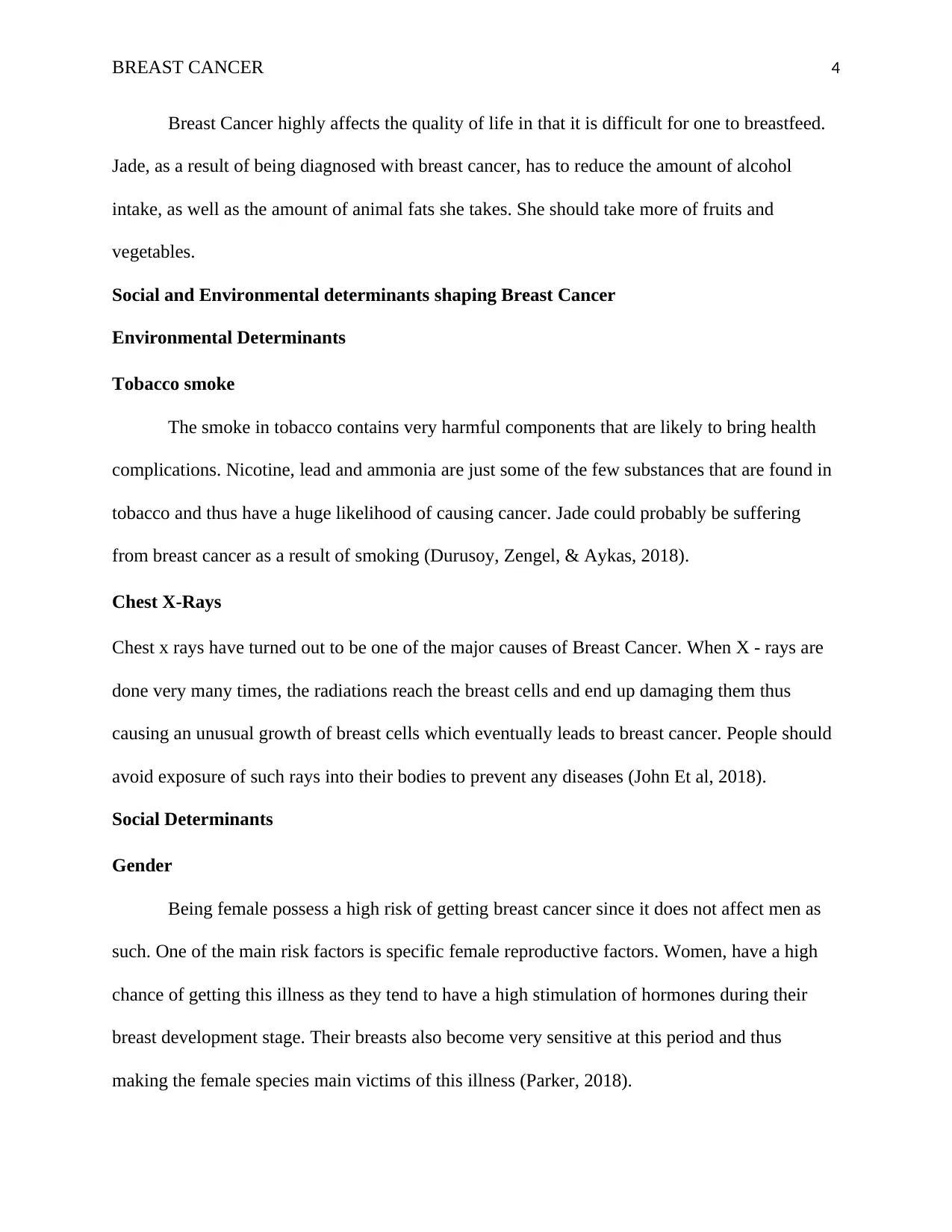
BREAST CANCER 4
Breast Cancer highly affects the quality of life in that it is difficult for one to breastfeed.
Jade, as a result of being diagnosed with breast cancer, has to reduce the amount of alcohol
intake, as well as the amount of animal fats she takes. She should take more of fruits and
vegetables.
Social and Environmental determinants shaping Breast Cancer
Environmental Determinants
Tobacco smoke
The smoke in tobacco contains very harmful components that are likely to bring health
complications. Nicotine, lead and ammonia are just some of the few substances that are found in
tobacco and thus have a huge likelihood of causing cancer. Jade could probably be suffering
from breast cancer as a result of smoking (Durusoy, Zengel, & Aykas, 2018).
Chest X-Rays
Chest x rays have turned out to be one of the major causes of Breast Cancer. When X - rays are
done very many times, the radiations reach the breast cells and end up damaging them thus
causing an unusual growth of breast cells which eventually leads to breast cancer. People should
avoid exposure of such rays into their bodies to prevent any diseases (John Et al, 2018).
Social Determinants
Gender
Being female possess a high risk of getting breast cancer since it does not affect men as
such. One of the main risk factors is specific female reproductive factors. Women, have a high
chance of getting this illness as they tend to have a high stimulation of hormones during their
breast development stage. Their breasts also become very sensitive at this period and thus
making the female species main victims of this illness (Parker, 2018).
Breast Cancer highly affects the quality of life in that it is difficult for one to breastfeed.
Jade, as a result of being diagnosed with breast cancer, has to reduce the amount of alcohol
intake, as well as the amount of animal fats she takes. She should take more of fruits and
vegetables.
Social and Environmental determinants shaping Breast Cancer
Environmental Determinants
Tobacco smoke
The smoke in tobacco contains very harmful components that are likely to bring health
complications. Nicotine, lead and ammonia are just some of the few substances that are found in
tobacco and thus have a huge likelihood of causing cancer. Jade could probably be suffering
from breast cancer as a result of smoking (Durusoy, Zengel, & Aykas, 2018).
Chest X-Rays
Chest x rays have turned out to be one of the major causes of Breast Cancer. When X - rays are
done very many times, the radiations reach the breast cells and end up damaging them thus
causing an unusual growth of breast cells which eventually leads to breast cancer. People should
avoid exposure of such rays into their bodies to prevent any diseases (John Et al, 2018).
Social Determinants
Gender
Being female possess a high risk of getting breast cancer since it does not affect men as
such. One of the main risk factors is specific female reproductive factors. Women, have a high
chance of getting this illness as they tend to have a high stimulation of hormones during their
breast development stage. Their breasts also become very sensitive at this period and thus
making the female species main victims of this illness (Parker, 2018).
Paraphrase This Document
Need a fresh take? Get an instant paraphrase of this document with our AI Paraphraser
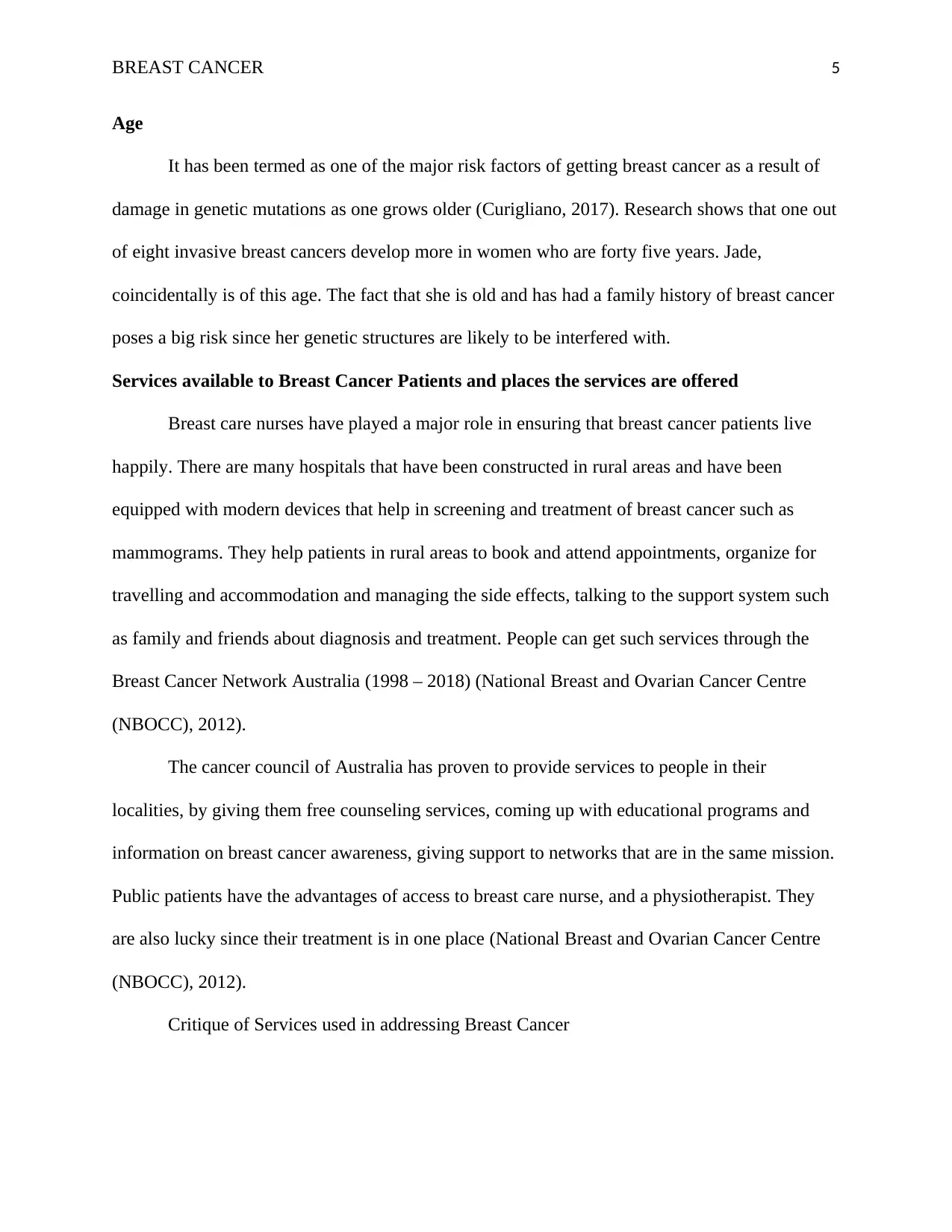
BREAST CANCER 5
Age
It has been termed as one of the major risk factors of getting breast cancer as a result of
damage in genetic mutations as one grows older (Curigliano, 2017). Research shows that one out
of eight invasive breast cancers develop more in women who are forty five years. Jade,
coincidentally is of this age. The fact that she is old and has had a family history of breast cancer
poses a big risk since her genetic structures are likely to be interfered with.
Services available to Breast Cancer Patients and places the services are offered
Breast care nurses have played a major role in ensuring that breast cancer patients live
happily. There are many hospitals that have been constructed in rural areas and have been
equipped with modern devices that help in screening and treatment of breast cancer such as
mammograms. They help patients in rural areas to book and attend appointments, organize for
travelling and accommodation and managing the side effects, talking to the support system such
as family and friends about diagnosis and treatment. People can get such services through the
Breast Cancer Network Australia (1998 – 2018) (National Breast and Ovarian Cancer Centre
(NBOCC), 2012).
The cancer council of Australia has proven to provide services to people in their
localities, by giving them free counseling services, coming up with educational programs and
information on breast cancer awareness, giving support to networks that are in the same mission.
Public patients have the advantages of access to breast care nurse, and a physiotherapist. They
are also lucky since their treatment is in one place (National Breast and Ovarian Cancer Centre
(NBOCC), 2012).
Critique of Services used in addressing Breast Cancer
Age
It has been termed as one of the major risk factors of getting breast cancer as a result of
damage in genetic mutations as one grows older (Curigliano, 2017). Research shows that one out
of eight invasive breast cancers develop more in women who are forty five years. Jade,
coincidentally is of this age. The fact that she is old and has had a family history of breast cancer
poses a big risk since her genetic structures are likely to be interfered with.
Services available to Breast Cancer Patients and places the services are offered
Breast care nurses have played a major role in ensuring that breast cancer patients live
happily. There are many hospitals that have been constructed in rural areas and have been
equipped with modern devices that help in screening and treatment of breast cancer such as
mammograms. They help patients in rural areas to book and attend appointments, organize for
travelling and accommodation and managing the side effects, talking to the support system such
as family and friends about diagnosis and treatment. People can get such services through the
Breast Cancer Network Australia (1998 – 2018) (National Breast and Ovarian Cancer Centre
(NBOCC), 2012).
The cancer council of Australia has proven to provide services to people in their
localities, by giving them free counseling services, coming up with educational programs and
information on breast cancer awareness, giving support to networks that are in the same mission.
Public patients have the advantages of access to breast care nurse, and a physiotherapist. They
are also lucky since their treatment is in one place (National Breast and Ovarian Cancer Centre
(NBOCC), 2012).
Critique of Services used in addressing Breast Cancer
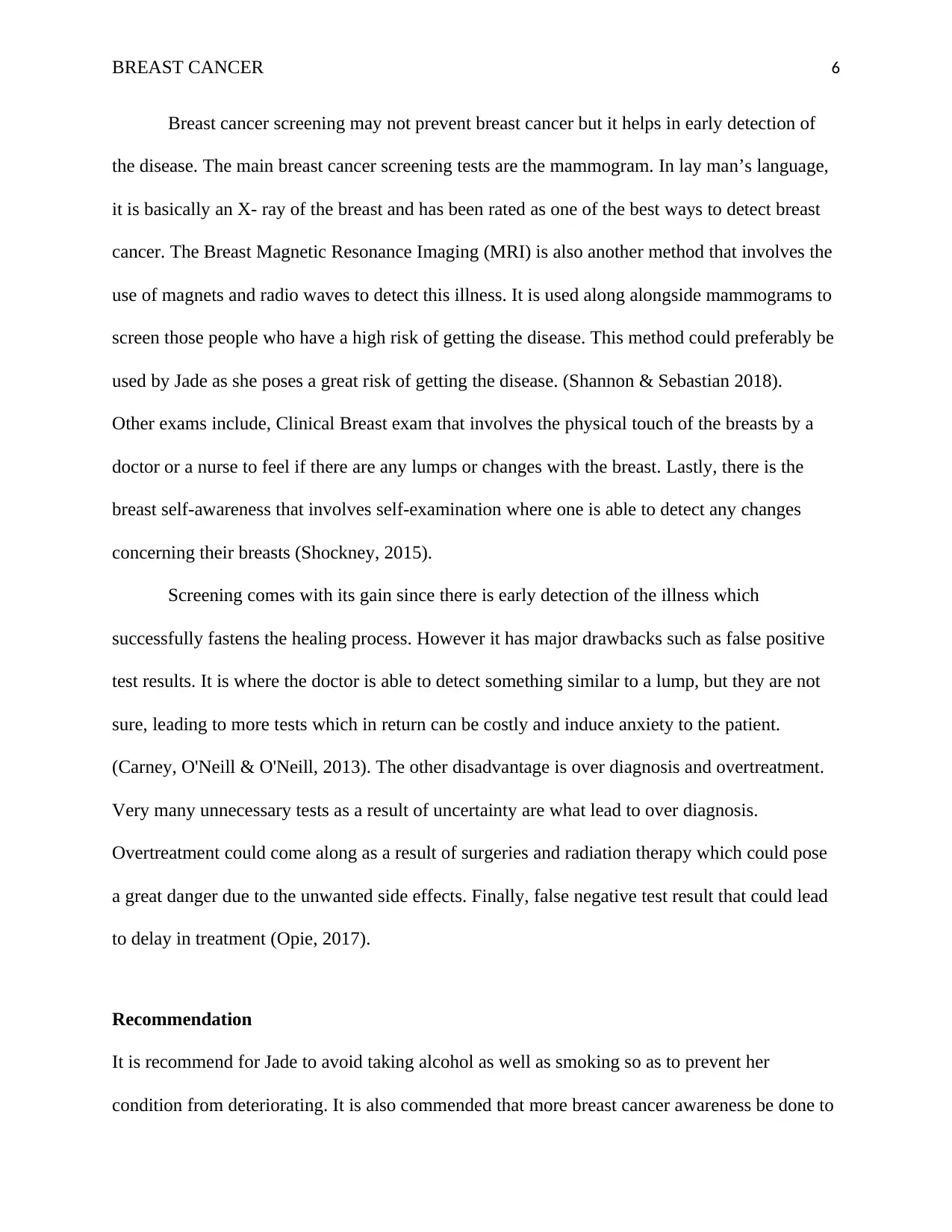
BREAST CANCER 6
Breast cancer screening may not prevent breast cancer but it helps in early detection of
the disease. The main breast cancer screening tests are the mammogram. In lay man’s language,
it is basically an X- ray of the breast and has been rated as one of the best ways to detect breast
cancer. The Breast Magnetic Resonance Imaging (MRI) is also another method that involves the
use of magnets and radio waves to detect this illness. It is used along alongside mammograms to
screen those people who have a high risk of getting the disease. This method could preferably be
used by Jade as she poses a great risk of getting the disease. (Shannon & Sebastian 2018).
Other exams include, Clinical Breast exam that involves the physical touch of the breasts by a
doctor or a nurse to feel if there are any lumps or changes with the breast. Lastly, there is the
breast self-awareness that involves self-examination where one is able to detect any changes
concerning their breasts (Shockney, 2015).
Screening comes with its gain since there is early detection of the illness which
successfully fastens the healing process. However it has major drawbacks such as false positive
test results. It is where the doctor is able to detect something similar to a lump, but they are not
sure, leading to more tests which in return can be costly and induce anxiety to the patient.
(Carney, O'Neill & O'Neill, 2013). The other disadvantage is over diagnosis and overtreatment.
Very many unnecessary tests as a result of uncertainty are what lead to over diagnosis.
Overtreatment could come along as a result of surgeries and radiation therapy which could pose
a great danger due to the unwanted side effects. Finally, false negative test result that could lead
to delay in treatment (Opie, 2017).
Recommendation
It is recommend for Jade to avoid taking alcohol as well as smoking so as to prevent her
condition from deteriorating. It is also commended that more breast cancer awareness be done to
Breast cancer screening may not prevent breast cancer but it helps in early detection of
the disease. The main breast cancer screening tests are the mammogram. In lay man’s language,
it is basically an X- ray of the breast and has been rated as one of the best ways to detect breast
cancer. The Breast Magnetic Resonance Imaging (MRI) is also another method that involves the
use of magnets and radio waves to detect this illness. It is used along alongside mammograms to
screen those people who have a high risk of getting the disease. This method could preferably be
used by Jade as she poses a great risk of getting the disease. (Shannon & Sebastian 2018).
Other exams include, Clinical Breast exam that involves the physical touch of the breasts by a
doctor or a nurse to feel if there are any lumps or changes with the breast. Lastly, there is the
breast self-awareness that involves self-examination where one is able to detect any changes
concerning their breasts (Shockney, 2015).
Screening comes with its gain since there is early detection of the illness which
successfully fastens the healing process. However it has major drawbacks such as false positive
test results. It is where the doctor is able to detect something similar to a lump, but they are not
sure, leading to more tests which in return can be costly and induce anxiety to the patient.
(Carney, O'Neill & O'Neill, 2013). The other disadvantage is over diagnosis and overtreatment.
Very many unnecessary tests as a result of uncertainty are what lead to over diagnosis.
Overtreatment could come along as a result of surgeries and radiation therapy which could pose
a great danger due to the unwanted side effects. Finally, false negative test result that could lead
to delay in treatment (Opie, 2017).
Recommendation
It is recommend for Jade to avoid taking alcohol as well as smoking so as to prevent her
condition from deteriorating. It is also commended that more breast cancer awareness be done to
⊘ This is a preview!⊘
Do you want full access?
Subscribe today to unlock all pages.

Trusted by 1+ million students worldwide
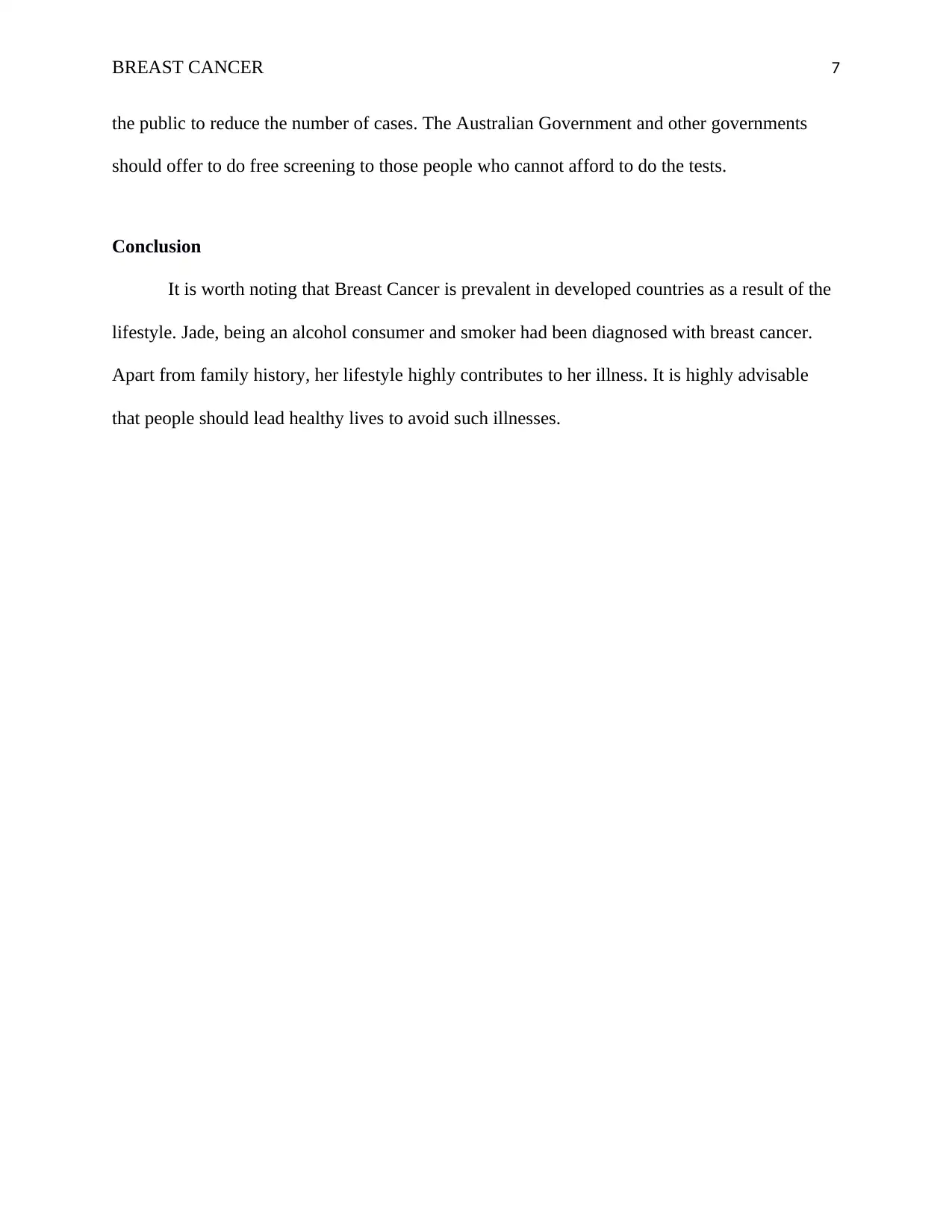
BREAST CANCER 7
the public to reduce the number of cases. The Australian Government and other governments
should offer to do free screening to those people who cannot afford to do the tests.
Conclusion
It is worth noting that Breast Cancer is prevalent in developed countries as a result of the
lifestyle. Jade, being an alcohol consumer and smoker had been diagnosed with breast cancer.
Apart from family history, her lifestyle highly contributes to her illness. It is highly advisable
that people should lead healthy lives to avoid such illnesses.
the public to reduce the number of cases. The Australian Government and other governments
should offer to do free screening to those people who cannot afford to do the tests.
Conclusion
It is worth noting that Breast Cancer is prevalent in developed countries as a result of the
lifestyle. Jade, being an alcohol consumer and smoker had been diagnosed with breast cancer.
Apart from family history, her lifestyle highly contributes to her illness. It is highly advisable
that people should lead healthy lives to avoid such illnesses.
Paraphrase This Document
Need a fresh take? Get an instant paraphrase of this document with our AI Paraphraser
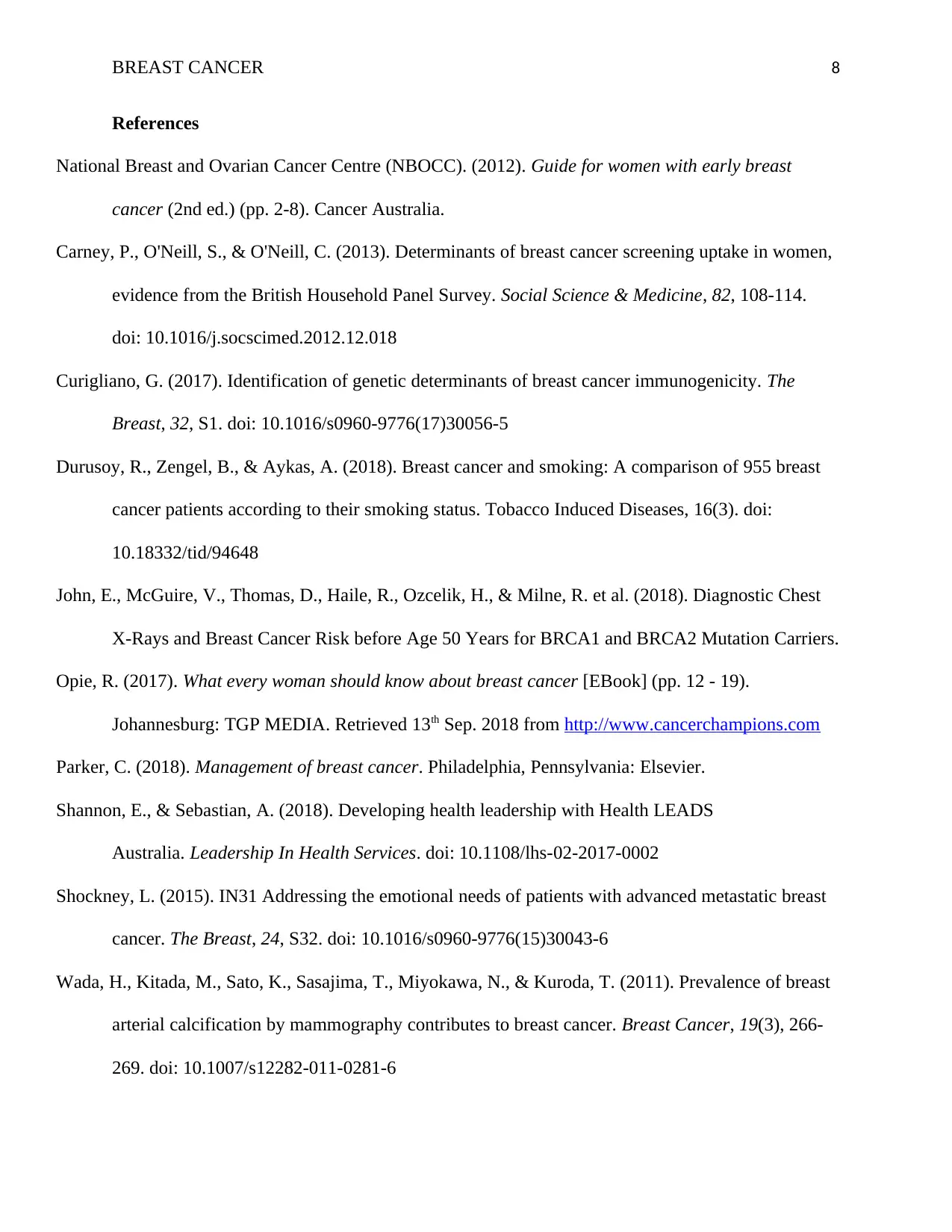
BREAST CANCER 8
References
National Breast and Ovarian Cancer Centre (NBOCC). (2012). Guide for women with early breast
cancer (2nd ed.) (pp. 2-8). Cancer Australia.
Carney, P., O'Neill, S., & O'Neill, C. (2013). Determinants of breast cancer screening uptake in women,
evidence from the British Household Panel Survey. Social Science & Medicine, 82, 108-114.
doi: 10.1016/j.socscimed.2012.12.018
Curigliano, G. (2017). Identification of genetic determinants of breast cancer immunogenicity. The
Breast, 32, S1. doi: 10.1016/s0960-9776(17)30056-5
Durusoy, R., Zengel, B., & Aykas, A. (2018). Breast cancer and smoking: A comparison of 955 breast
cancer patients according to their smoking status. Tobacco Induced Diseases, 16(3). doi:
10.18332/tid/94648
John, E., McGuire, V., Thomas, D., Haile, R., Ozcelik, H., & Milne, R. et al. (2018). Diagnostic Chest
X-Rays and Breast Cancer Risk before Age 50 Years for BRCA1 and BRCA2 Mutation Carriers.
Opie, R. (2017). What every woman should know about breast cancer [EBook] (pp. 12 - 19).
Johannesburg: TGP MEDIA. Retrieved 13th Sep. 2018 from http://www.cancerchampions.com
Parker, C. (2018). Management of breast cancer. Philadelphia, Pennsylvania: Elsevier.
Shannon, E., & Sebastian, A. (2018). Developing health leadership with Health LEADS
Australia. Leadership In Health Services. doi: 10.1108/lhs-02-2017-0002
Shockney, L. (2015). IN31 Addressing the emotional needs of patients with advanced metastatic breast
cancer. The Breast, 24, S32. doi: 10.1016/s0960-9776(15)30043-6
Wada, H., Kitada, M., Sato, K., Sasajima, T., Miyokawa, N., & Kuroda, T. (2011). Prevalence of breast
arterial calcification by mammography contributes to breast cancer. Breast Cancer, 19(3), 266-
269. doi: 10.1007/s12282-011-0281-6
References
National Breast and Ovarian Cancer Centre (NBOCC). (2012). Guide for women with early breast
cancer (2nd ed.) (pp. 2-8). Cancer Australia.
Carney, P., O'Neill, S., & O'Neill, C. (2013). Determinants of breast cancer screening uptake in women,
evidence from the British Household Panel Survey. Social Science & Medicine, 82, 108-114.
doi: 10.1016/j.socscimed.2012.12.018
Curigliano, G. (2017). Identification of genetic determinants of breast cancer immunogenicity. The
Breast, 32, S1. doi: 10.1016/s0960-9776(17)30056-5
Durusoy, R., Zengel, B., & Aykas, A. (2018). Breast cancer and smoking: A comparison of 955 breast
cancer patients according to their smoking status. Tobacco Induced Diseases, 16(3). doi:
10.18332/tid/94648
John, E., McGuire, V., Thomas, D., Haile, R., Ozcelik, H., & Milne, R. et al. (2018). Diagnostic Chest
X-Rays and Breast Cancer Risk before Age 50 Years for BRCA1 and BRCA2 Mutation Carriers.
Opie, R. (2017). What every woman should know about breast cancer [EBook] (pp. 12 - 19).
Johannesburg: TGP MEDIA. Retrieved 13th Sep. 2018 from http://www.cancerchampions.com
Parker, C. (2018). Management of breast cancer. Philadelphia, Pennsylvania: Elsevier.
Shannon, E., & Sebastian, A. (2018). Developing health leadership with Health LEADS
Australia. Leadership In Health Services. doi: 10.1108/lhs-02-2017-0002
Shockney, L. (2015). IN31 Addressing the emotional needs of patients with advanced metastatic breast
cancer. The Breast, 24, S32. doi: 10.1016/s0960-9776(15)30043-6
Wada, H., Kitada, M., Sato, K., Sasajima, T., Miyokawa, N., & Kuroda, T. (2011). Prevalence of breast
arterial calcification by mammography contributes to breast cancer. Breast Cancer, 19(3), 266-
269. doi: 10.1007/s12282-011-0281-6
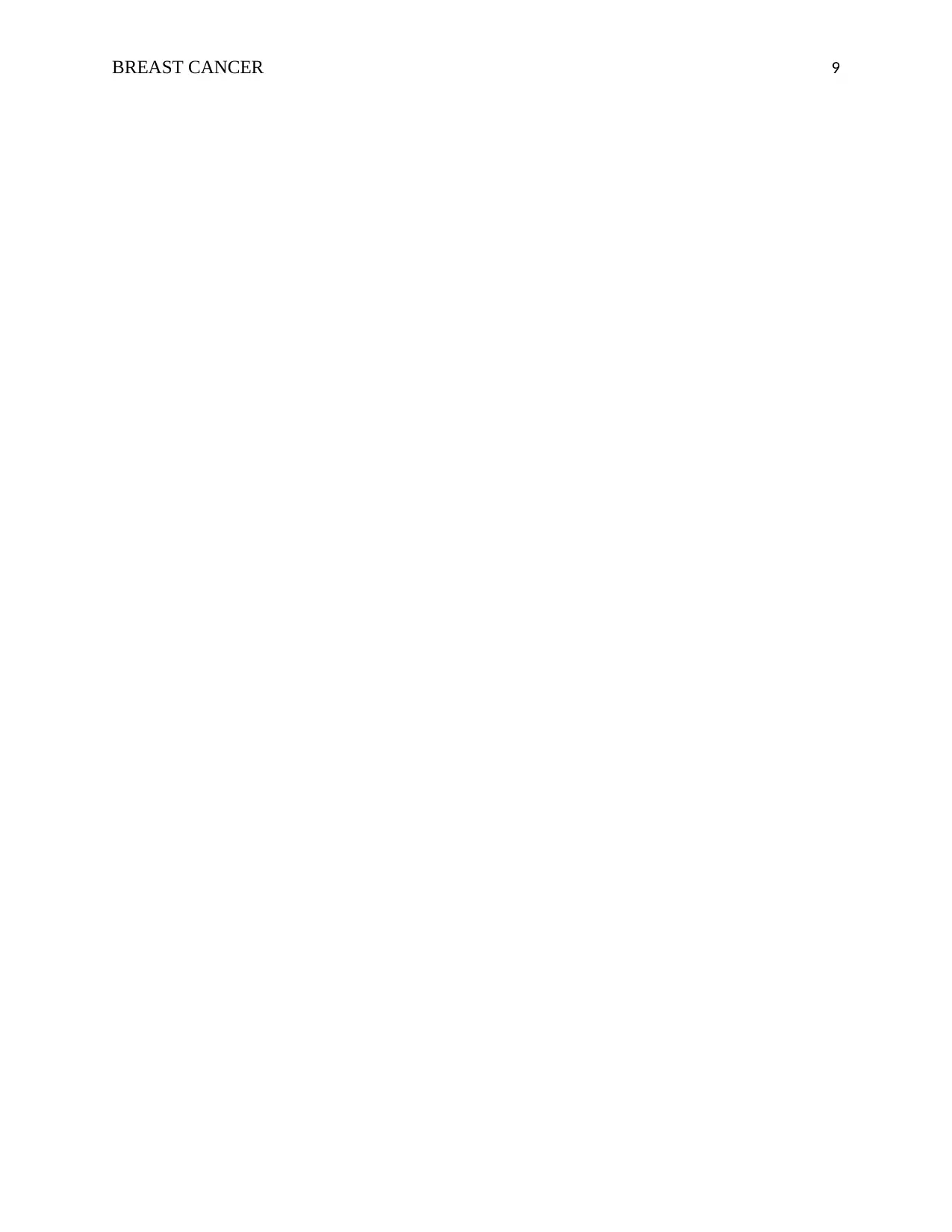
BREAST CANCER 9
⊘ This is a preview!⊘
Do you want full access?
Subscribe today to unlock all pages.

Trusted by 1+ million students worldwide
1 out of 9
Related Documents
Your All-in-One AI-Powered Toolkit for Academic Success.
+13062052269
info@desklib.com
Available 24*7 on WhatsApp / Email
![[object Object]](/_next/static/media/star-bottom.7253800d.svg)
Unlock your academic potential
Copyright © 2020–2025 A2Z Services. All Rights Reserved. Developed and managed by ZUCOL.





